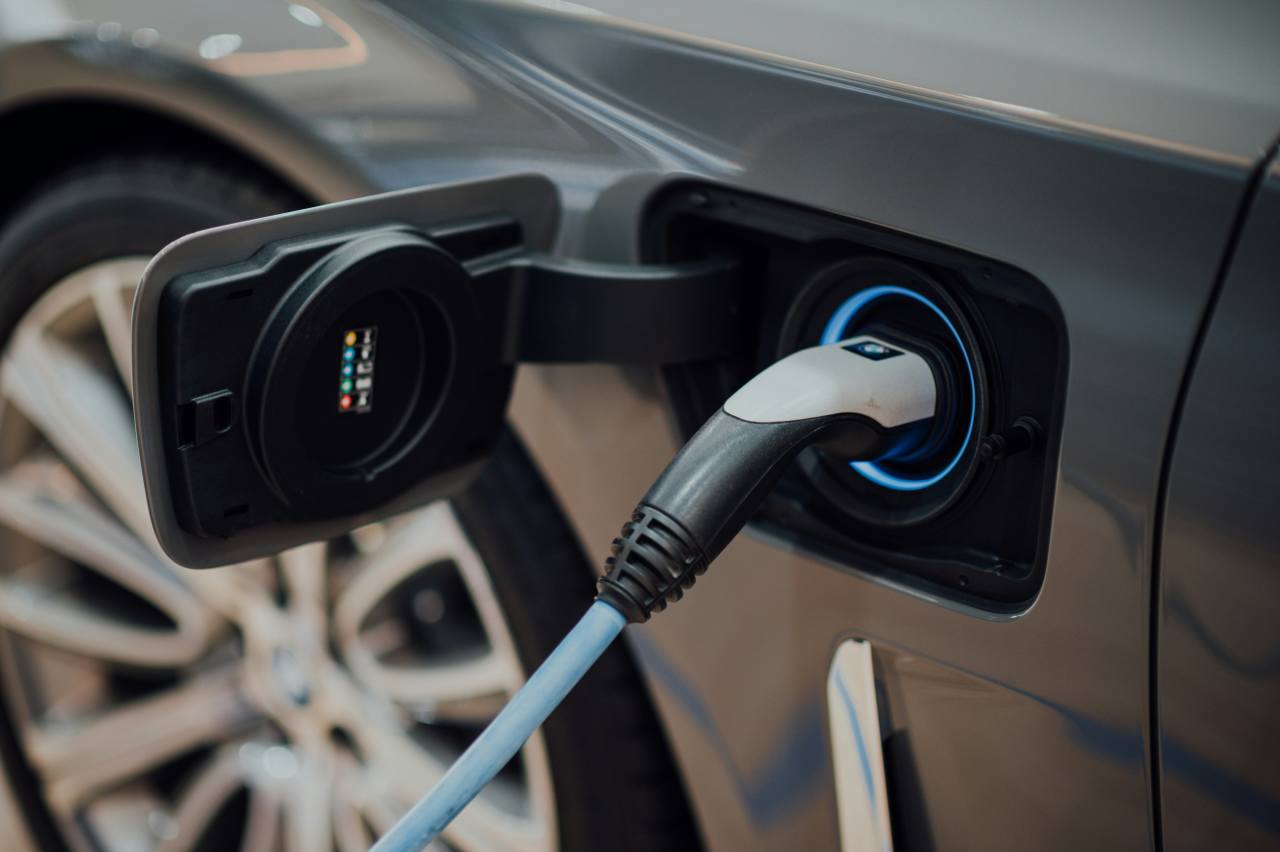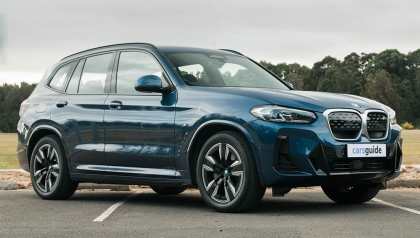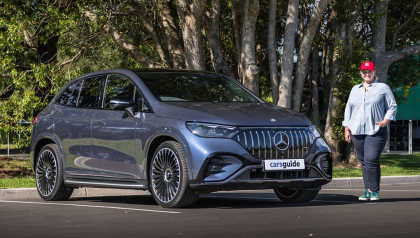The Polestar 3 has entered an electric SUV market where pillowy designs seem to be the design-focus for car manufacturers.
If that's what you're after, you won't find it here. The new Polestar 3 is a sharply styled large electric SUV. It's nailed its looks, it's got the power and the EV powertrain will enthrall enthusiasts but will its 'unfinished' tech get in the way of its success?
We've been testing the top Long Range Dual Motor model with Performance Pack to find out how the new Polestar 3 handles family life.
Price and features – Does it represent good value for the price? What features does it come with? 7/10
7 / 10
There are two variants available for the Polestar 3 Long Range, a Single Motor and a Dual Motor, but a few different packs can be added to the chosen variant to further personalise it.
We're in the top-grade Dual Motor with Performance Pack; a pack that adds $11,700 to the 'base' Dual Motor variant and brings its price tag to $144,420 MSRP.
The Performance Pack adds 'Swedish Gold' accents on the seatbelts, ambient lighting system, tyre valves and calipers. There are Brembo brakes behind the 22-inch performance wheels and the chassis has been tuned for performance.

Standard kit for this model includes adaptive air suspension, adaptive LED headlights and LED tail-lights, keyless start/entry and three-zone climate control. The Android Automotive system runs a few different built-in Google apps like Google Assistant, Maps and YouTube. An update later in the year should see Apple CarPlay become integrated.
Other equipment includes a panoramic sunroof, 14.5-inch multimedia touchscreen, 360-degree view camera system, a powered tailgate, at home charging cable and electric front seats with heat function and extendable under-thigh supports.
Now come the little extras.

Our test model has the $2000 optional black 'Space' paintwork and 'Plus Pack' which adds $9000 and includes a head-up display, a 25-speaker Bowers & Wilkins audio system, active noise cancelling tech, a foldable boot floor, heated steering wheel and rear outboard seats, power-operated steering column, air quality filtering for the air-conditioning system and soft close doors.
There is also an upgraded Nappa pack for $7500 which adds animal welfare secured (which almost feels like a misnomer) Nappa leather upholstery from Bridge of Weir, black ash deco panels and front seats with five massage modes, powered side support and ventilation function.
The top-model grade more than holds its own in terms of motor outputs compared to its rivals the BMW iX xDrive 50 Sport and Mercedes-Benz EQE 500 SUV, but the BMW has it beat with a longer driving range.

And despite technicality sitting as the most affordable with its base price, the extra packs our test model has put it at over $180K drive-away and, well, that feeling of value starts to slide for me.
Design – Is there anything interesting about its design? 8/10
8 / 10
Where the Polestar 2 is mid-size, the Polestar 3 looks enormous but both feature what I like to refer to as Polestar minimalism. Crisp lines showcase the body without ever looking flashy.
There’s a distinct, growly edge to the Polestar 3 which its rivals lack with their pillowy designs and there’s no other word for it - it's hot.
While the thoughtfully sourced Nappa leather is a nice touch, it feels like virtue signalling to have the fact stencilled on the seats themselves. I don't need to know that it used 8.1kg of CO2e per square metre of material to produce, but it might float your boat.

This supple material is set against some lovely soft-touch knit fabrics that look great but easily pick up marks.
The Swedish Gold accents in the seatbelts and ambient lighting add some personality but the cabin looks too similar to its far more affordable sedan cousin for its price point.
The simply-styled but high-end looking interior won’t appeal to all, especially not when you’re considering the cabins of its flashier rivals but there is something beautiful in its minimalism.


Practicality – How practical is its space and tech inside? 7/10
7 / 10
The best part of the Polestar 3 cabin is the space available for all occupants! What it lacks in a third row, it more than makes up for in legroom. So, if you have a couple of lanky teenagers in tow, they'll be happy.
Passenger access is excellent via the wide door apertures and 202mm ground clearance. The front seats offer the most comfort with their heat, ventilation and five-mode massage functions. However, the rear seats are ergonomic and well-padded, so even back there, you won't get fatigue on a longer journey.
Storage isn't as clever as it could be but you still get some solid options. There's a glove box (opened via the touchscreen) that can fit a manual; a middle console, under-shelf cubby that has an elastic tech pouch and a centre console that features two cupholders and a phone cradle.

In the rear you get small storage bins in each door, two cupholders in a fold-down centre armrest and two map pockets.
Other amenities in the rear are okay but not class-leading, especially not for a top-grade model. Back rowers get climate control, heated outboard seats, two USB-C ports and reading lights but that's about it. A few practical items like sun blinds and extra storage options would be good for a family SUV at this price point.
The boot offers a maximum of 597L of storage capacity available when all five seats are in use but that can be bumped up to 1411L when the rear row is folded. The rear row has a 60/40 split with a ski-port door that adds variation to the configuration.

A level loading space makes it an easy car to slide gear in and out of. The floor folds up to reveal a large storage pocket underneath which is a handy spot for when you only have a few items and don’t want them rolling around.
Like most EVs you don’t get a spare tyre, just a tyre repair kit but you do get a powered tailgate with kick function.
Now we come to what has become the least practical aspect of the cabin for my family and that's the technology.

There's no denying the 14.5-inch portrait-style multimedia touchscreen looks awesome. And when it works, it's great. But the emphasis is on 'when it works'.
If you’re familiar with the Volvo systems, you’ll figure it out, but if you’re not - expect to spend some quality one-on-one time with the system because this isn't a simple ‘get in and go’ set up.
It's run by Android Automotive which means you get a whole bunch of Google apps built-in, like Maps, Assistant and Google Play. There are others, like YouTube, Spotify and Tidal as well. A software update later in the year should see Apple CarPlay enabled.

The system seems to have a few gremlins and there are sporadic moments where the touchscreen functionality stops, or menus/functions can't be accessed. As when the key fob battery was low and the wireless charging pad could not be enabled. A full reset on the system was required to restore functionality.
Outside of volume control, everything is accessed via the screen and that means you're one glitch away from not being able to use the vehicle optimally or open your glove box.
The 25-speaker Bowers & Wilkins surround sound system with Dolby Atmos is nice, though.
Under the bonnet – What are the key stats for its motor? 8/10
8 / 10
Our test model is a dual motor all-wheel-drive, with two 180kW permanent magnetic motors at each end of the vehicle. The Performance Pack adds a software upgrade which boosts the outputs (20kW/70Nm) and together this model produces up to 380kW of power and 910Nm of torque.
This gives you an impressive 0-100km/h sprint time of just 4.7-seconds and a top speed of 210km/h.
The chassis has been tuned with performance in mind and there is torque vectoring on the rear axle, as well as a rear motor disconnect clutch to save power at lower speeds.
Despite its massive outputs, I haven’t felt overwhelmed by the power but it has plenty of it to ensure a quick on-road experience. You certainly don’t feel like you can’t overtake!
Efficiency – What is its driving range? What is its charging time? 8/10
8 / 10
The Long Range Dual Motor with Performance Pack has a lithium ion battery with a large 111kWh of capacity but its claimed WLTP driving range is only up to 567km which positions it in the middle of its rivals.
This isn’t a bad driving range but I’d want an even longer one for a family SUV because it means less time at the charging stations with your kids on a road trip.
The Polestar 3 has a Type 2 CCS charging port and it can be connected to a rapid DC charger. It can accept up to 250kW on this type of system, which is excellent.
An 11kW AC or 50kW DC charger will take up to 11 hours or two and a half hours to charge, respectively.
Our test model has an official claimed WLTP energy consumption range between 21.9 to 23kWh/100km and after a mix of open and city driving we managed to hit an average of 20.4kWh, which is good for such a big EV.
Driving – What's it like to drive? 7/10
7 / 10
I have been a little surprised by the top-model grade this week. It’s got heaps of power and your tummy does a little leap when you really have to put your foot down but the strong regen braking and adjustable one-pedal function (up to two levels) take a long time to get used to and sometimes it just feels like it's champing at the bit but not in a fun, sports car way.
The Polestar 3 sits lower to the ground than some other large SUVs but it’s not as steady as I would expect in cornering. The adaptive suspension is adjustable depending on the drive mode you select but remains fairly firm and you feel the bigger bumps.
The visibility is great and none of the pillars are in the way from my driving position, the frameless side mirrors also add a wide view into your blind spots.
The active noise cancelling tech means the cabin is delightfully quiet and it's very easy to chat with the back seat passengers. I’ve hated that you can’t ‘close’ the sunroof though because despite there being little to no heat, the constant sunlight is really annoying.
The 360-degree view camera system is high quality and despite a few fish-eye lens angles you can get, this is a very easy SUV to park.
My dad struggled with the concept of not turning the car on or off, and in his words "it just feels wrong!". This is a Polestar experience though that you get used to (eventually).
However, the aspect I struggled with is that you get two 'keys' - an easily lost key fob and a keycard (same size as a credit card).
You apparently need both to access the vehicle - the keycard to unlock/open the doors if the key fob proximity feature doesn't register and the key fob to actually drive.
Although, at a pinch the keycard is technically a second key and can be used to drive if the battery on the key fob runs out. Oh, did I mention you have to charge the key fob? It all seems a bit superfluous.
Safety – What safety equipment is fitted? What is its safety rating? 8/10
8 / 10
The Polestar 3 hasn't been assessed by ANCAP yet, so is unrated, but there's not much it doesn’t have when it comes to its safety equipment and it features nine airbags which is great for a family SUV.
The standard safety kit includes adaptive cruise control, blind-spot monitoring, driver monitoring, lane departure warning, lane keeping aid, parking assist, traffic sign recognition, 360-degree camera system, front and rear parking sensors, rear cross-traffic alert, tyre pressure monitoring and occupant detection alert.
Some highlight features include an alarm system with interior motion sensors, automatic unlocking in a collision, emergency e-call, and Volvo's 'Whiplash Injury Protection System' consisting of energy absorbing backrests and specially designed head restraints in the front seats.

The adaptive cruise control is great but has one too many steps to get it going.
The Polestar 3 has forward and rear collision warning, as well as AEB with cyclist, pedestrian and car detection.
There are two ISOFIX child seat mounts and three top tether anchor points on the rear seats but two seats will fit best.

Ownership – What warranty is offered? What are its service intervals? What are its running costs? 8/10
8 / 10
Polestar offers the Polestar 3 with a five-year/unlimited warranty and the battery is covered by an eight-year or up to 160,000km warranty. You also get a free service plan for the first five years or up to 100,000km of ownership, whichever comes first.
Considering its position in the premium-end of the EV market, this is good value compared to its Euro rivals.
Verdict
The Polestar 3 Long Range Dual Motor with Performance Pack offers a lot of good stuff and in a segment filled with jellybean-on-wheels-designs, it looks great!
It’s large and comfortable enough for a family but the technology feels overworked and that hurts its functionality for me. So much so that at times it feels like you were driving a phone, rather than a car.
Pricing Guides



_0.jpg)

.jpg)






